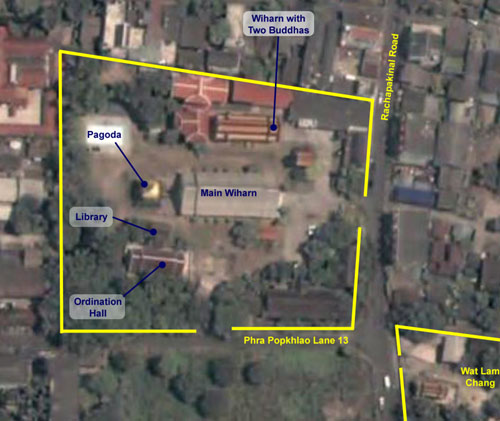Wat Chiang Man
You can take it with you.
Wish you could have this information with you when you visit Chiang Mai? Now you can. Check out our ebook guides.
Located within the walls of the old city, near the Chang Puak gate, Chiang Man is the oldest temple in Chiang Mai. It was supposedly built by the founder of the city 700 years ago, King Mengrai, on the spot where he stayed while planning his new capital. It's a small temple, and not on the main tourist trail, but it was important for quite some time.
Several small buildings dot the temple compound, and behind the main prayer hall is a chedi. The base of the pagoda is lined with elephants crafted out of plaster. All the other buildings are finely decorated in the Northern style, with red lacquer, gold leaf and many-colored mirrors. Of special interest is the roof and stairs of the Wiharn to the right of the main chapel which houses two sacred Buddha images. The stair banisters are colorful naga dragons typical of the North. The roof gable-ends also forms beautiful nagas using colored glass and mirror tiles.

There are two images housed in the wiharn to the right of the main prayer hall. The wiharn itself appears to have been constructed around a sort of traditional Northern-style prang which houses the images. One image is a marble bas-relief Buddha supposed to have come from Sri Lanka 2,000 years ago. The second image is a crystal Buddha from Lopburi, and is thought to be about 1,800 years old.
While looking at the images, you might notice the system of pipes, a pump and a basin at the side of the altar. These are used to bathe the images in an annual ritual around the Thai New Year (Songkran).
The windows of the main prayer hall are also worth a close look. The frames are tiled with colored mirrors while the shutters for the windows sport gold leaf stencil patterns on both sides of the red lacquer panels.
Beside the pagoda is the temple's library (ho trai), and next to that is the ordination hall (ubosot). The ubosot is usually closed to the public, but on one side of the porch you can see a stone tablet. It dates from the late sixteenth century and recounts the founding of Chiang Mai by King Mengrai in the thirteenth century. There's a copy of the stele in the Chiang Mai Art & Culture Center just a short walk away, near the Three Kings Monument in the middle of town.
Getting There
Wat Chiang Man is on Ratchaphakhinai Road near where it intersects Sri Phum Road, which runs just inside the moat along the north wall of the old city. The closest "landmark" to Wat Chiang Man is the Thai Airways office on Phrapokklao Road. Walk down the small street next to the office and turn left at the next main street. The temple will be on your left.
